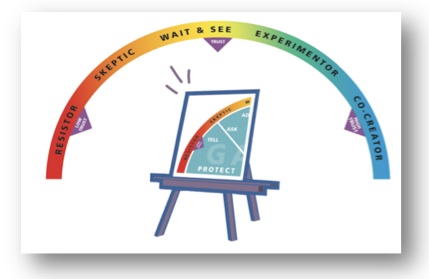
Years ago I was called in to work with a high-profile entertainment company in Hollywood. The company culture was rife with destructive politics, the owners were not in sync, and distrust characterized the company’s way of life. Over the course of several months, I assessed the company’s leaders, diagnosed the nature of their challenges, and saw that distrust was going to be the company’s undoing unless leadership put the real issues on the table. The company’s directors decided to take 25 executives out of town for a retreat to do what they had avoided for years—talk straight with one another. I was asked to facilitate the meeting.
As the first morning session got underway, I could practically taste the fear in the room. People were avoiding eye contact and were sitting as far away as possible from those with whom they had issues. The steady buzz of nervous small talk reminded me of the first day of school after summer break—awkward and tense.
As I stood quietly at the front of the room, an idea came to me that would turn out to be a game changer—both for them and for me.
Figure 8–2: The Gauge

On a large flipchart I drew an arc. At the far left of the arc, I wrote “Resistor,” then “Skeptic,” followed by “Wait-and-see” in the middle. To the right, I wrote “ExperiMentor,” and to the far right “Co-creator.” After giving my graphic a name—The ARC of Engagement (The Gauge)—I turned to the gathered executives and said, “I’d like you each to identify where you are on this gauge.” As the silence stretched on, I found myself tensing up. What if they didn’t take up my challenge? Then I heard a voice in the back say, “I’m sitting in ‘skeptical’; I don’t believe that we’re going to make any headway over the next few days.”
My butterflies disappeared as people began to speak about how they were feeling, with a level of openness I had not seen from the group before. After two days, the leadership team had generated numerous powerful insights into the company’s troubles, as well as ideas about how to transform their culture. Over the next few years, this moderately successful entertainment company became the darling of Hollywood studios. Its business took a quantum leap forward, and within a few years, the company’s revenues increased more than twentyfold. More importantly, it now had a reputation as a great place to work, and was attracting new talent. Every executive who attended that first weekend retreat remembers it as the beginning of a journey into trust that laid the foundation for success moving forward.
After that weekend, I interviewed the attendees and captured their feelings both going into the meeting and coming out:
COO of the Organization
Going in, there was a lot of trepidation. Someone said they thought they were being sent away to a “growth camp.” I think people were afraid that if they didn’t “grow,” they were going to be fired. No one was given a choice about participating, which was probably a good thing. If we had been told we could opt out, everyone would have. The real fear was that if we participated and somehow failed, we would be out of a job.
Before that weekend I used to compare us to a submarine, all submerged. But today, we can have discussions about things we would never discuss before. We talk about performing and not performing; we discuss conflicts that occur. We get through the discussions with honest communication. Our business has transformed itself.
By using the Conversational Dashboard Tool, the executives learned to see where people were in the conversation—“Protect and Primitive Brain” or “Partner and Executive Brain.” This experience brought with it great insights; as the executives learned to map the interaction dynamics taking place in the room, they could see what types of interactions disabled conversations and what types enabled healthy conversations. Once they understood how to have productive conversations, the team took control of their destiny.
In addition to using Conversational Dashboards to see where people are in a conversation, teams also can learn to reframe, refocus, and redirect their conversations to move them from a protective stance to a partnering one. These “three Rs” can help you interrupt a conversational pattern that is not working and let you access Level III wisdom in the moment, even in the face of conflict or the negative power of emotional triggers.
Navigating to New Places
To begin, let’s imagine that you are starting to use Conversational Dashboards in your meetings and interactions with colleagues to determine everyone’s frame of mind. Let’s say you find people are generally Resistors or Skeptics, and are in a closed state of mind. When this occurs, you will want to ask them a discovery question such as, “What would it take for you to feel more engaged or to want to co-create?” Asking discovery questions is a profoundly important yet simple way of getting people to move toward more co-creative ways of engaging in conversations. There are times, however, when this may not work, and you may need to transform the conversational space so you and others can move forward together. This is when you draw upon transformative conversational skills such as reframing, refocusing, and redirecting.
Excerpt from “Conversational Intelligence: How Great Leaders Build Trust and Get Extraordinary Results” by Judith Glaser (Routledge, Paperback, November 2016).
Judith E. Glaser is the CEO of Benchmark Communications, Inc. and the Chairman of The Creating WE Institute. She is an Organizational Anthropologist and the author of the best-selling book, “Conversational Intelligence” (Original Edition: 2013; Routledge Reprint Edition – 2016), as well as a consultant to Fortune 500 companies. For more information, visit: www.creatingwe.com; www.conversationalintelligence.com



